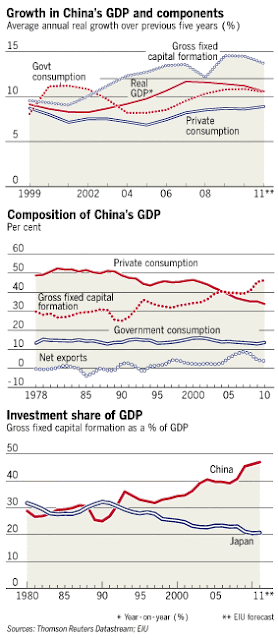The second is that they lived in the days of consumption always exceeding capacity mainly because of ever increasing population growth rate though there were periods, during the economic decline phase, when consumption failed. But a slowing population growth rate or, worse, a declining population was never the contributory factor. So to rely on their ideas for a solution to the current global economic crisis, which has been exacerbated by a falling population growth rate, won't get us anywhere. Theirs were valid only for their times.
As for technology, the progress was already evident in Adam Smith's time. Although the Industrial Revolution was in its early days, the fruits of the Agricultural Revolution, which actually was a precondition for the Industrial Revolution, had been evident. Factory production had also been established though still powered by water — steam powered factory machinery was only made feasible when James Watt produced a rotary-motion steam engine in 1781. Technology therefore was not a differentiating factor between then and now.
Therefore Adam Smith (1723-1790) with his Theory of Absolute Advantage and David Ricardo (1772-1823) with his Theory of Comparative Advantage were strong advocates of free trade. The British economy then was the world's leading economy, so it was to its advantage that trade was free. Also Adam Smith was, first and foremost, a moral philosopher who was more concerned with maximisation of employment rather than profit. As free trade created a bigger market for Britain's produce while enabling its workers to buy cheaper food imports, its benefits were in accord with Smith's stance. Had he lived today, he would have railed against free trade and would have certainly disowned its modern-day champions.
In military-speak, the supporters of free trade are still fighting a second generation war (2GW) in which mass bombardment is the order of the day. Now warfare is in its fourth generation (4GW), characterised by the entry of a large number of non-state combatants. If a nation-state still uses 2GW strategy to fight 4GW opponents, it's a war that the nation-state is condemned to lose, as is unfolding in Afghanistan.
Although capacity was the constraining factor then while now it's consumption, the Nikolai Kondratieff's (1892-1938) cycle of economic growth and decline was equally valid then as now. Kondratieff's argument was that overinvestment (growth phase) led to overcapacity and layoffs which reduced demand (decline phase). In this, he was roughly but not precisely right. Much better was Karl Marx (1818-1883) who was spot on but only in regards to the decline phase.
If the decline phase had been just a case of overcapacity, the climb out of the depths would've been easy because an across-the-board cut in capacity would've restored the pre-decline situation. But what makes a recovery intractable is the extreme imbalance in the suffering. Any supposed solution — deficit spending, tax on the rich, pay cut, inflation — is only a palliative measure because the extreme imbalance won't be redressed. As long as the technology remains as is, whatever money spent goes back to the rich. The only cure comes from technological progress. Joseph Schumpeter (1883-1950) coined a euphemistic term, 'creative destruction', for it. The right term is wealth destruction; old wealth must be destroyed through the introduction of new technologies so that the generation of new wealth could proceed unabated.
However, before even both Kondratieff and Schumpeter identified the technology driven solution to an economic decline, Alfred Marshall (1842-1924) had already cottoned on to this idea. The key difference between Marshall and Marx was that Marshall observed what was going in the factories. Marx never stepped foot into one. What he observed was the conditions in the Manchester slums. Had he done so, we'd have been toasting the Marxist system now.
In the first three Kondratieff waves, every time a technology solution arose, the population was ever ready to grow to absorb the increased production. Now the Fourth Kondratieff wave has again unleashed massive production capacity but this time the constraint to be unclogged is no longer technology. Instead, it's biology, to be exact, the human fertility rate. Technology cannot solve this. But technology is adapting itself to address this drastically changed paradigm. The Fifth Kondratieff wave is ushering in technologies that provide pinpoint answers to human needs. Need a component? Worry not, a 3D printer will print it, one unit only, no more no less, on the spot. Need chemotherapy? Instead of chemotherapy, molecular target therapy can precisely target the cancerous tissue without affecting others surrounding it.
Finally, the last common factor that bind these philosophers together is that they never substituted mathematics for their keen observations unlike the current generation of economists who put mathematics at the forefront of their thought process, akin to putting the cart before the horse. No wonder no great economic ideas have of late percolated from their blinkered minds. To be sure, some of the great philosophers did resort to mathematical rigours to test their ideas but mathematics was always kept in the background. Here's how, as written in Wikipedia, Alfred Marshall described his use of mathematics to support his economic ideas:
- Use mathematics as shorthand language, rather than as an engine of enquiry.
- Keep to them till you have done.
- Translate into English.
- Then illustrate by examples that are important in real life.
- Burn the mathematics.
- If you can't succeed in (4), burn (3). This I do often.
We can do one better than Marshall. Instead of using mathematics, we can resort to the plethora of patterns in the real world to illustrate the mechanics of an economic wave. For example, its 4C underpinning is based on an observation of product movements on the factory shop floor while the skewing of wealth towards the end of an economic wave is gleaned from the Monopoly board game.
Regardless, Marx and Marshall deserve the the credit for being the first to get it right, albeit each getting half right, in describing the growth and decline of an economic wave. Marx also has the last word, if not the last laugh at seeing the eventual collapse of capitalism, since he was the one who coined the label 'capitalism'.

























